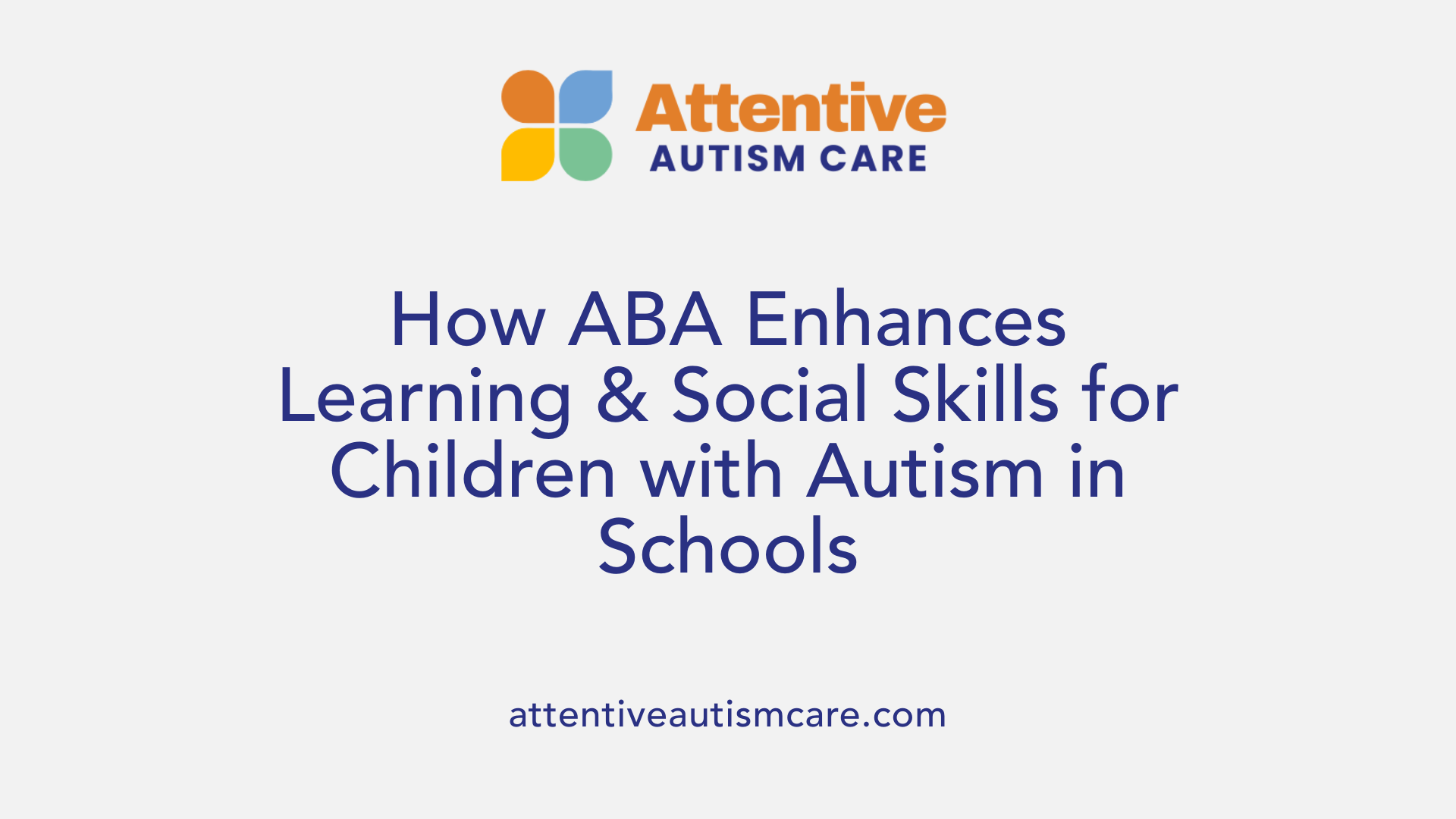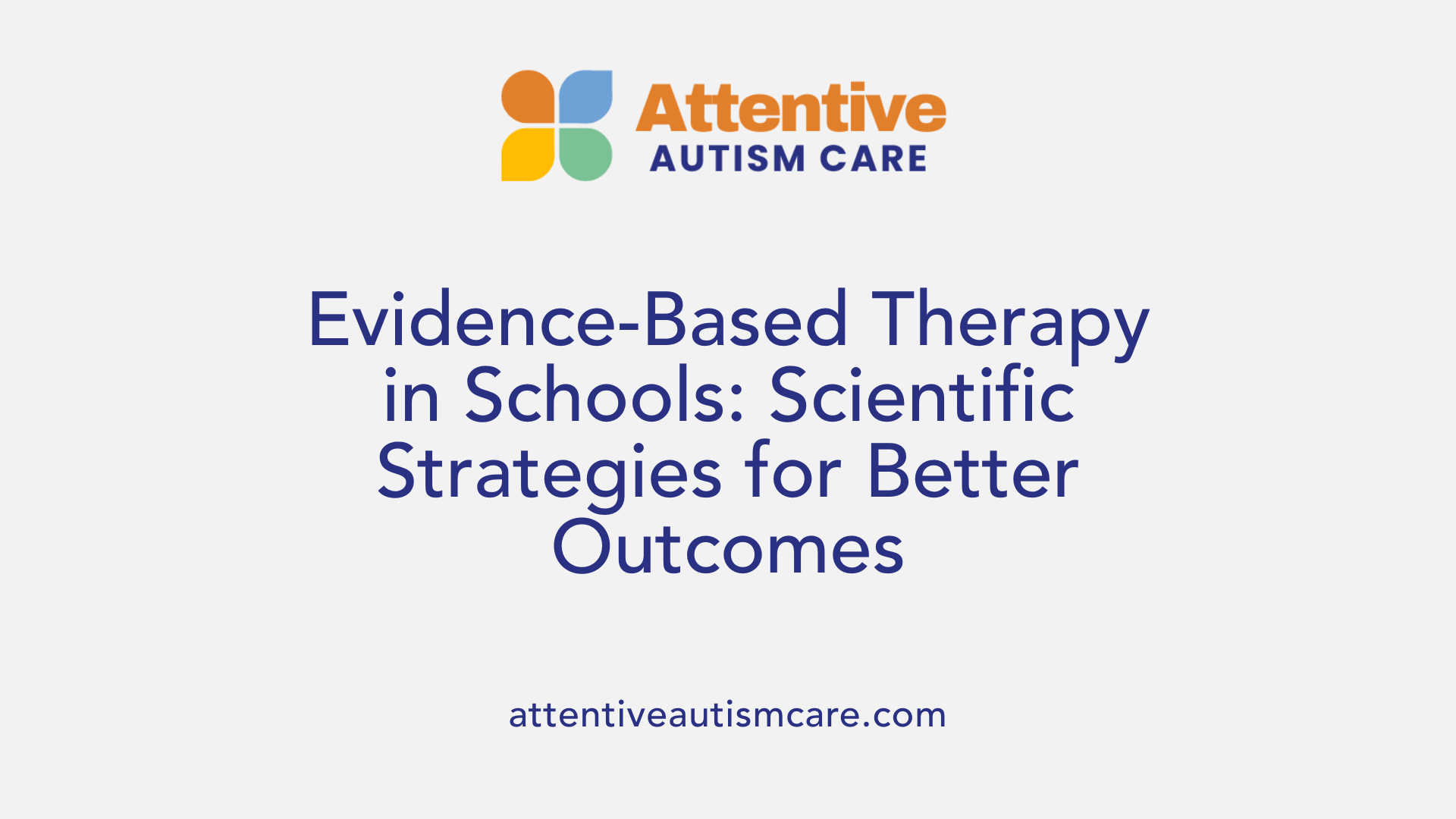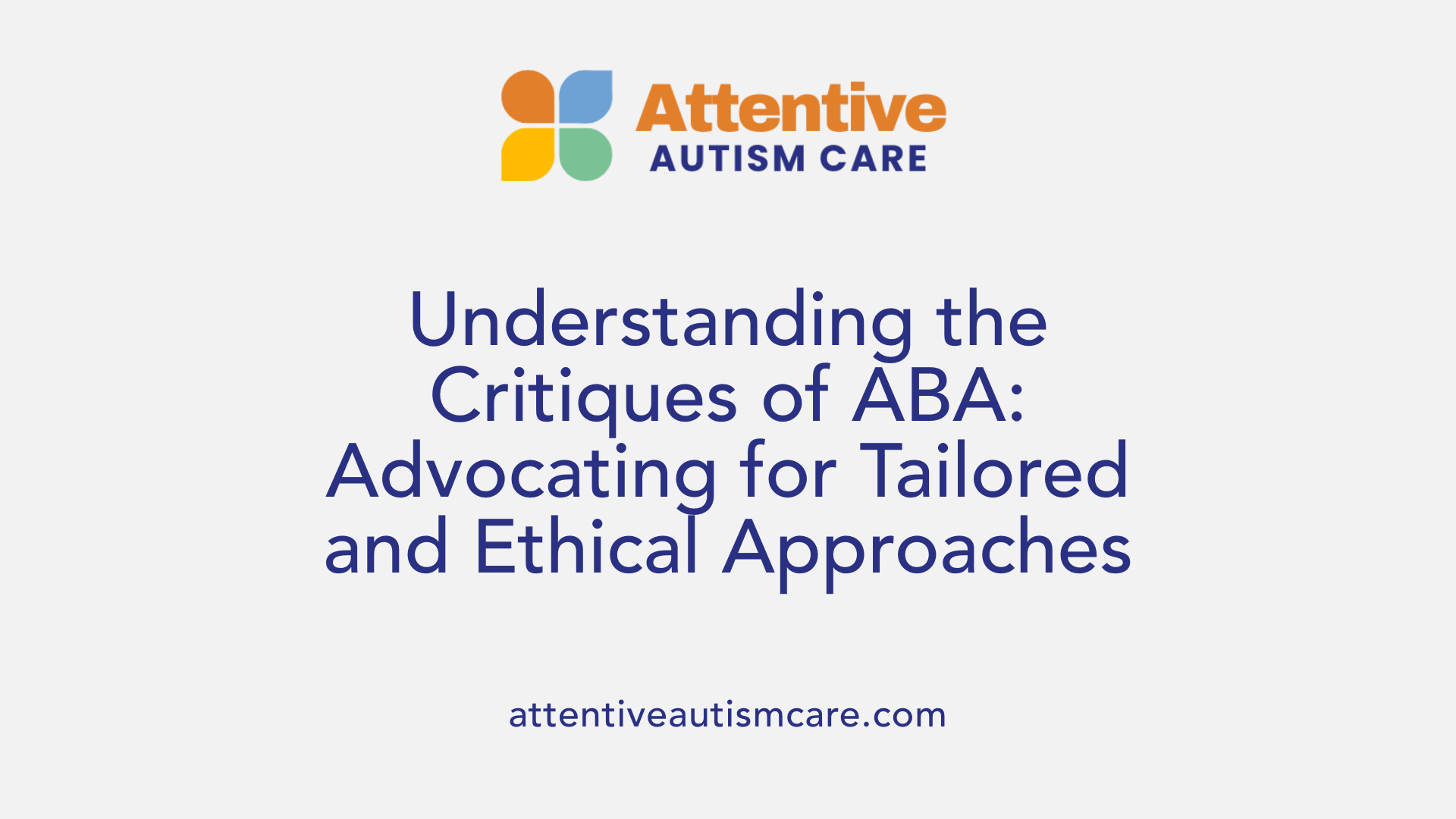How to Advocate for Autism Services in Schools
Empowering Families: Navigating Autism Services within Educational Systems

Understanding and Advocating for Autism Services in Schools
As awareness of autism spectrum disorder (ASD) grows, so does the need for effective advocacy to secure appropriate services within educational settings. Parents, educators, and caregivers often face challenges in navigating the complex landscape of therapies, interventions, and educational plans tailored for autistic children. This article outlines key approaches, therapies such as Applied Behavior Analysis (ABA), and strategies families can employ to advocate effectively for autism services in schools, ensuring their children receive personalized support that enhances learning and development.
What is Applied Behavior Analysis (ABA) Therapy and Its Role in Schools?
What is Applied Behavior Analysis (ABA) therapy?
Applied Behavior Analysis (ABA) therapy is a science-based, individualized treatment approach designed to understand and modify behaviors to support individuals with autism spectrum disorder (ASD). It focuses on encouraging positive behaviors, such as improved communication, social skills, and learning abilities, while reducing challenging ones. ABA relies on analyzing the environment, including antecedents and consequences, to shape behavior effectively.
What techniques are used in ABA?
ABA therapy employs a variety of strategies, including:
- Positive reinforcement: Rewarding desired behaviors to increase their frequency.
- Prompting and fading: Providing cues to initiate behavior then gradually removing them to build independence.
- Modeling: Demonstrating behaviors for imitation.
- Behavior chaining: Breaking complex tasks into smaller steps for easier learning.
- Extinction: Withholding reinforcement for unwanted behaviors to reduce them.
- Redirection and script fading: Guiding individuals away from undesirable behaviors and providing verbal or visual guides for social skills.
Where is ABA therapy delivered?
ABA programs are highly flexible and can be provided in diverse settings such as:
- Home environments
- School classrooms
- Community locations This flexibility allows services to be tailored based on individual needs and daily routines.
What is the empirical support for ABA in ASD?
ABA is the most extensively studied and empirically supported therapy for individuals with ASD. Research demonstrates its effectiveness in producing meaningful improvements in IQ, adaptive behavior, social communication, and reducing challenging behaviors. Early Intensive Behavioral Intervention (EIBI) based on ABA principles further highlights the benefits when started early.
How are ABA programs individualized?
ABA is not a one-size-fits-all therapy. Each plan is crafted based on thorough assessments of the individual's unique skills, challenges, and interests. Ongoing monitoring allows modifications to maximize progress. Qualified behavior analysts oversee these programs ensuring interventions meet specific developmental and educational goals.
| Aspect | Details | Importance |
|---|---|---|
| Definition | Science-based approach focusing on behavior modification | Establishes foundation for interventions |
| Techniques | Positive reinforcement, prompting, modeling, chaining, extinction | Diverse methods address varied needs |
| Settings | Home, school, community | Enhances generalization and accessibility |
| Empirical support | Extensive research showing efficacy in ASD | Validates ABA as primary treatment method |
| Individualization | Customized plans by qualified analysts with ongoing assessments | Ensures effectiveness and relevance |
How ABA Improves Outcomes for Children with Autism in Educational Environments

How does ABA therapy help individuals with autism?
ABA therapy applies scientifically validated techniques such as positive reinforcement, behavior modeling, prompting, and fading to build useful skills and reduce challenging behaviors. By tailoring interventions to each child's unique needs, it enhances key areas including communication, social interaction, attention, and daily living skills. This approach supports greater independence and better integration into educational settings and the community.
Skill development through ABA
Techniques like behavior chaining and script fading break complex tasks into manageable steps, helping children master academic and social skills effectively. Visual supports and modeling enable children to understand expectations and imitate appropriate behaviors, boosting learning in everyday environments.
Reduction of challenging behaviors
ABA strategies such as extinction, redirection, and behavior contracts reduce unwanted behaviors by systematically withholding reinforcement for problem behavior while encouraging positive alternatives. This creates a safer and more supportive classroom atmosphere conducive to learning.
Early intervention impact
Early Intensive Behavioral Intervention (EIBI) based on ABA principles, often provided intensively in early childhood, significantly improves IQ and adaptive functioning. Engaging children during formative years maximizes developmental gains and paves the way for sustained progress.
Communication and social skill gains
Naturalistic Developmental Behavioral Interventions (NDBI), including models like the Early Start Denver Model, focus on social engagement and communication within natural settings. Parent-mediated programs further extend these benefits by involving caregivers in therapy, enhancing joint attention, language abilities, and reducing challenging behaviors.
Quality of life improvements
Through individualized behavior analytic services, classroom and home environments can be optimized via scheduled supports like toileting training and sleep hygiene routines, improving overall well-being. The comprehensive use of ABA thus not only advances educational outcomes but also enhances daily life experiences for children with autism.
Professional Roles and Providers of ABA Therapy and Related Services in Schools
Who Typically Provides ABA Therapy Services?
ABA therapy services are primarily delivered by Board Certified Behavior Analysts (BCBAs), who are highly trained, credentialed professionals responsible for designing, evaluating, and overseeing individualized treatment programs for individuals with autism spectrum disorder (ASD).
Supporting the BCBA are Registered Behavior Technicians (RBTs) and paraprofessionals. RBTs implement the daily interventions directly with clients, following BCBA-designed plans, while paraprofessionals may assist in carrying out therapeutic activities under supervision.
Behavior Consultation and Assistant Behavior Consultation
Behavior Consultation-ABA services involve comprehensive assessments and planning, often conducted by BCBAs or Board Certified Assistant Behavior Analysts (BCaBAs). BCaBAs, who typically hold a Bachelor's degree, contribute to treatment development and conduct assessments under BCBA supervision.
Assistant Behavior Consultation-ABA services provide additional support to behavior consultants by assisting with direct implementation and monitoring of interventions, ensuring treatment fidelity and effectiveness.
Responsibilities of Behavior Health Technicians
Behavior Health Technicians (BHTs) carry out individual treatment plans that involve ABA interventions. They work closely with BCBAs and RBTs to deliver services addressing behavioral needs in various settings such as home, school, or community environments.
Coordination with Medical Professionals
The delivery of ABA services begins with diagnosis from medical or developmental specialists. BCBAs collaborate with healthcare providers, educators, and families to ensure integrated care, aligning behavioral interventions with medical and educational goals.
This multidisciplinary approach ensures that ABA therapy is both evidence-based and tailored to meet the diverse developmental and behavioral needs of individuals with ASD in school settings.
Behavioral Challenges Addressed by ABA and School-Based Interventions
What kinds of behavioral challenges can ABA therapy address in autism?
ABA therapy is highly effective in addressing many behavioral challenges faced by individuals with autism spectrum disorder (ASD).
It targets aggression and tantrums by using techniques such as positive reinforcement and redirection to reduce these disruptive behaviors and teach appropriate alternatives. Self-stimulatory behaviors are managed through behavior contracts, extinction, and replacement behaviors to support engagement in socially constructive activities.
Social skills deficits are improved with modeling, script fading, and naturalistic developmental strategies like the Early Start Denver Model. These help enhance communication, imitation, joint attention, and social interaction in natural settings. Sensory sensitivities are addressed by tailoring interventions to the child’s needs, often incorporating behavioral strategies that promote tolerance and coping.
Emotional regulation and executive function challenges are addressed by incorporating Cognitive Behavioral Therapy (CBT) elements and ABA principles, supporting individuals in managing anxiety, attention, and mood fluctuations.
Daily living skills improvement—including toileting, eating, and sleep routines—is another focus area of ABA. Methods such as shaping, graduated guidance, and scheduled toileting are tailored to the child’s developmental level to increase independence.
Together, these interventions are delivered in individualized or group formats within schools or community settings to maximize relevance and generalization. By emphasizing reinforcement, prompting, and fading, ABA fosters meaningful growth while respecting neurodiversity and personal strengths.
| Behavioral Challenge | ABA Techniques Used | Intervention Focus |
|---|---|---|
| Aggression and Tantrums | Positive reinforcement, redirection, extinction | Reducing disruptive behaviors, teaching alternatives |
| Self-stimulatory Behaviors | Behavior contracts, modeling, replacement behaviors | Replacing repetitive actions with adaptive skills |
| Social Skills Deficits | Modeling, script fading, naturalistic approaches | Enhancing communication and social interaction |
| Sensory Sensitivities | Tailored behavioral strategies | Increasing tolerance and coping skills |
| Emotional Regulation & Exec. Function | CBT elements, ABA strategies | Managing anxiety, mood, attention |
| Daily Living Skills | Shaping, graduated guidance, scheduled routines | Promoting independence in toileting, sleep, eating |
These school-based ABA interventions create supportive environments that encourage skill development, decrease challenging behaviors, and improve overall functioning for children with autism.
Early Intensive Behavioral Intervention (EIBI) and Naturalistic Developmental Behavioral Interventions (NDBI) in Schools
What Are the Principles of Early Intensive Behavioral Intervention (EIBI) Based on ABA?
EIBI draws directly from Applied Behavior Analysis (ABA) principles, focusing on intensive, individualized teaching sessions that promote positive behaviors and skill development. ABA techniques such as reinforcement, prompting, and behavior chaining are central to EIBI, making the interventions highly structured and data-driven.
How Does EIBI Improve IQ and Adaptive Behaviors?
Multiple studies confirm that EIBI significantly enhances cognitive abilities and daily functioning in children with Autism Spectrum Disorder (ASD). Through consistent and personalized behavioral interventions, children often show notable improvements in IQ scores and essential adaptive behaviors like communication and social skills.
What Is the Introduction to Naturalistic Developmental Behavioral Interventions (NDBI)?
NDBI represents a more natural approach grounded in ABA, where teaching happens within everyday, spontaneous interactions. It aims to build skills by engaging children in typical social and communication environments rather than structured drills.
How Does NDBI Focus on Interaction in Natural Settings?
Unlike EIBI, NDBI emphasizes learning in real-life contexts—such as playtime or routine activities—to foster meaningful communication and social engagement. This natural setting interaction helps generalize skills across various environments.
What Are the Effects of NDBI on Language and Communication?
Research shows that NDBI methods like the Early Start Denver Model promote moderate positive outcomes in language development, imitation skills, and social communication. These improvements support children's ability to connect with peers and adults, enhancing their overall educational experience.
Parent-Mediated Interventions: Enhancing Family Involvement in School-Based Autism Services
What are Parent-Mediated Interventions (PMI)?
Parent-mediated interventions are approaches that actively involve parents in the therapy and education of their children with autism spectrum disorder (ASD). Grounded in principles of Applied Behavior Analysis (ABA), these interventions equip parents with strategies to support their child's development in natural settings, particularly within the school environment.
How do Programs like P-ESDM function?
The Parent-Implemented Early Start Denver Model (P-ESDM) is a notable program that trains parents to use early behavioral and developmental strategies during everyday routines. This training enables parents to become consistent and effective facilitators of their child’s social and communication growth, increasing the daily opportunities for skill acquisition.
In What Ways do PMIs Improve Joint Attention, Language, and Social Skills?
PMIs have shown significant improvements in key areas such as joint attention – the ability to share focus on an object or event with others – as well as language development and broader social communication skills. By empowering parents to apply intervention techniques during natural interactions, children demonstrate more frequent engagement and enhanced communication abilities.
How do PMIs Help Reduce Challenging Behaviors?
These interventions also contribute to a reduction of challenging behaviors by providing parents with tools to recognize and respond to triggers effectively. Consistent parental involvement in the intervention creates a more stable and supportive environment, which decreases behavioral issues.
Why is Collaboration Between School and Families Important in PMI?
Successful parent-mediated interventions depend heavily on a collaborative partnership between families and school personnel. This joint effort ensures consistency in intervention strategies across home and school settings, fostering an integrated support system. Schools can offer guidance and resources, while parents provide crucial reinforcement, creating a comprehensive approach to the child’s development.
This blend of school-based support and parent-led intervention forms a cornerstone for effective autism services, promoting stronger developmental outcomes and enhancing the overall educational experience for children with ASD.
Specialized Behavioral Strategies for Addressing Specific Challenges in Schools
Sleep Hygiene Interventions
Sleep issues are common among children with ASD and can severely affect learning and behavior at school. Behavioral strategies such as establishing consistent sleep hygiene routines, applying fading bedtime techniques, scheduled awakenings, and using contingency reinforcement have proven effective in improving sleep patterns. These methods help create predictable and calming bedtime environments to support restful sleep.
Toilet Training Techniques Based on ABA
Toilet training can be particularly challenging for children with autism, but ABA-based techniques have shown success. Strategies such as shaping behaviors gradually, providing graduated guidance, and using scheduled toileting adapted to the child's age and cognitive level help increase independence and decrease accidents. Individualized approaches ensure the child progresses at a comfortable pace.
Communication Supports Like PECS
Enhancing communication is critical in educational settings. The Picture Exchange Communication System (PECS) is widely used to develop communication skills, especially for requesting and initiating conversations. PECS uses visual symbols to promote interaction and is effective in improving children’s ability to express needs and engage socially.
Use of Visual Supports Such as TEACCH
Structured learning environments supported by visual aids, as seen in TEACCH programs, assist children with ASD in understanding daily routines and learning tasks more effectively. Visual schedules, charts, and clear physical organization reduce confusion and support independence, fostering better engagement with educational material.
Reducing Caregiver Stress Through Structured Interventions
Implementing structured interventions with visual supports not only benefits students but also helps reduce stress for caregivers and educators. By clarifying expectations and providing consistent approaches, these methods contribute to a more manageable and positive learning environment, although further research is needed to optimize outcomes.
| Intervention Type | Description | Benefits in School Setting |
|---|---|---|
| Sleep Hygiene | Routines, fading bedtime, scheduled awakenings, reinforcement | Improved sleep, better daytime functioning |
| ABA Toilet Training | Shaping, guidance, scheduled toileting | Increased independence, fewer accidents |
| PECS | Picture-based communication system | Enhanced requesting and social interaction |
| TEACCH Visual Supports | Structured environment with visual aids | Greater understanding, reduced anxiety |
| Structured Interventions | Use of visuals and routines to clarify expectations | Lower caregiver stress, consistent behavior support |
Group Versus Individual ABA Services in Educational Contexts
What are Group ABA Therapy Formats?
Group ABA therapy involves providing intensive therapeutic interventions within a group setting. These sessions can include social skills groups, peer interaction activities, and behavioral skill-building exercises designed to be practiced with peers. Group formats capitalize on social learning opportunities, allowing individuals to observe and model behaviors demonstrated by others.
What are School-Based Group Programs?
School-based group programs offer ABA interventions within the educational environment. These programs integrate behavior analytic strategies during the school day, supporting academic achievement, social communication, and classroom behavior management. Such structured programs provide continuity with educational goals and allow for peer interaction under professional guidance.
What are After School and Summer Therapeutic Programs?
These programs extend ABA services beyond regular school hours and into summer breaks. They provide consistent support in less structured environments, helping to generalize skills learned during school-based settings. After school and summer ABA groups often focus on social engagement, recreational skills, and adaptive behaviors.
What are Individual Targeted Interventions?
Individual ABA services include one-on-one behavior consultations, mobile therapy, and Behavior Health Technician (BHT) sessions tailored to meet specific behavioral needs. These interventions are customized to address particular challenges such as social skills deficits, communication needs, or daily living skills, allowing for focused attention and flexible adjustment to the individual's progress.
What are the Benefits of Both Approaches?
Group interventions foster peer interaction, social learning, and generalization of social skills, while individual services provide personalized goals and intensive support targeting unique behavioral challenges. Combining both approaches can maximize skill acquisition and behavioral improvements by addressing diverse needs within educational contexts.
| Service Type | Settings | Key Features |
|---|---|---|
| Group ABA Therapy | Schools, Community | Supports peer interaction, social skill development |
| School-based Group Programs | Educational Institutions | Aligns with school curriculum, classroom behavior focus |
| After School/Summer Programs | Community, School | Enhances skill generalization in less structured times |
| Individual Services | Home, School, Community | Personalized, targeted interventions on specific needs |
Understanding Evidence-Based Therapy (EBT) Within School Settings

What is Evidence-Based Therapy (EBT)?
Evidence-Based Therapy (EBT) refers to therapeutic methods that are backed by scientific research demonstrating their effectiveness. These therapies utilize proven techniques to bring about positive behavior changes and improve mental health outcomes.
Examples of EBT: Multi-Systemic Therapy (MST) and Functional Family Therapy (FFT)
MST is a comprehensive, intensive intervention designed for youth involved in criminal activities. It addresses various aspects of the young person's environment including family, school, and community to promote lasting behavioral improvements. Similarly, FFT is aimed at at-risk adolescents and focuses on improving family dynamics to reduce problematic behaviors.
Focus on Behavior Change
Both MST and FFT center on modifying behaviors through structured, evidence-backed strategies. These therapies work by identifying behavioral patterns and intervening with techniques that have been scientifically validated to foster positive change.
Application in School Settings
In schools, EBT supports at-risk youth by addressing behavioral and emotional challenges that can affect learning and social interaction. Through targeted interventions like MST and FFT, educational environments can become more supportive, helping students succeed academically and socially.
Overall, EBT offers schools a framework of scientifically supported interventions that promote healthier behaviors and improve outcomes for youths facing behavioral and emotional difficulties.
Core ABA Techniques Employed in School-Based Autism Therapy
How is reinforcement used in ABA therapy?
Positive reinforcement encourages desired behaviors by following them with rewards, which increases the likelihood those behaviors will occur again. Negative reinforcement, on the other hand, helps increase skills by removing unpleasant elements when the individual displays the targeted behavior. Both forms motivate children to adopt functional skills and reduce challenging behaviors.
What role do modeling and visual supports play?
Visual modeling provides clear examples of behaviors through videos, charts, and pictures, making it easier for autistic children to understand and imitate desired actions. This method taps into their strong visual learning abilities, enhancing acquisition of social and communication skills.
How are prompting and fading applied?
Prompting involves giving cues or assistance to initiate a behavior. Fading gradually reduces these prompts so the child gains independence in performing the skills. This stepwise withdrawal helps children solidify new abilities while minimizing reliance on external aids.
How do behavior chaining and contracts support learning?
Behavior chaining breaks complex tasks into smaller, teachable steps that are linked sequentially. This technique simplifies learning intricate skills by focusing on each component in turn. Behavior contracts are formal written agreements that clearly define expected behaviors alongside their rewards or consequences, helping reinforce behavioral expectations and accountability.
What is the purpose of extinction and redirection?
Extinction reduces challenging behaviors by withholding their usual reinforcements, which may cause a temporary increase in those behaviors (an extinction burst) before they decline. Redirection steers individuals away from undesired behavior toward positive activities, effectively managing disruptions within the classroom or therapy setting.
How does script fading help with social skills?
Script fading uses verbal or written guides to assist children in learning social interactions or complex tasks. By gradually removing the scripts, individuals can build confidence and competence in spontaneous social communication.
These core ABA techniques create a structured and supportive environment that fosters meaningful skill development in children with autism, particularly in school-based therapy settings.
Challenges and Critiques of ABA: Considerations for Advocates in Schools

Are there any criticisms or limitations associated with ABA therapy?
While Applied Behavior Analysis (ABA) is widely recognized for its effectiveness in supporting individuals with Autism Spectrum Disorder (ASD), it has faced several important criticisms. Historically, some ABA methods included aversive techniques intended to reduce undesirable behaviors. Although modern ABA no longer utilizes these methods, their past use has contributed to wariness among some families and advocates.
Critics also express concern about the potential rigidity of ABA programs. These interventions sometimes emphasize repetitive routines and conformity, which might not fully respect a child's unique personality or neurodiverse traits. This approach can unintentionally suppress individuality by prioritizing behavioral compliance over personal expression.
Respecting neurodiversity is essential. Some opponents argue that traditional ABA may overlook sensory preferences and differences, applying a one-size-fits-all model rather than tailoring interventions to each child's specific needs. This can lead to frustration or emotional distress for children if therapy does not accommodate their preferences and sensitivities.
The intensity and duration of ABA therapy are further points of concern. Intensive programs can be demanding, potentially causing stress and fatigue. Advocates stress the importance of balancing therapy intensity with the child's overall well-being and happiness to avoid emotional harm.
In response to these concerns, many practitioners now emphasize ethical, personalized ABA approaches that involve collaboration with families and respect for the child's individuality. This modern focus helps mitigate past criticisms and highlights the importance of adapting interventions to foster both skill development and emotional health.
| Critique Area | Concerns | Modern Approach or Consideration |
|---|---|---|
| Historical Aversive Methods | Use of punishment-based techniques in the past | Discontinued in ethical, contemporary ABA practice |
| Rigidity and Conformity | Emphasis on repetitive tasks and behavior compliance possibly suppressing individuality | Increased use of flexible, child-centered strategies |
| Neurodiversity Respect | Standardized interventions not accommodating sensory and personal differences | Tailored plans respecting sensory and communication needs |
| Therapy Intensity | Stress and fatigue from demanding therapy schedules | Balancing therapeutic goals with well-being and family input |
| Ethical Concerns | Risk of emotional harm if interventions are not carefully supervised | Strong emphasis on ethical guidelines, family collaboration, and informed consent |
Understanding In-Home and Behavioral Health Services (IBHS) as Part of School Advocacy

What is IBHS and what is its purpose?
In-Home and Behavioral Health Services (IBHS) provide support for children, youth, or young adults under 21 who face mental, emotional, or behavioral challenges. These services aim to help individuals improve their functioning through targeted behavioral interventions and support systems.
Who is eligible for IBHS?
To qualify for IBHS, the individual must have a diagnosed behavioral health disorder. This diagnosis is crucial to ensure the person receives the appropriate care tailored to their specific behavioral needs.
Where can IBHS be delivered?
IBHS can be offered in various settings including the individual's home, school, or other community environments. This flexibility allows services to blend naturally with daily routines and school activities, making it easier to integrate support with educational goals.
What types of services are available within IBHS?
Services under IBHS include various Applied Behavior Analysis (ABA) approaches such as Behavior Analytic services, Behavior Consultation-ABA, Assistant Behavior Consultation-ABA, and Behavior Health Technician-ABA services. These focus on assessing behavior, developing individualized intervention plans, and implementing strategies to increase positive behaviors and reduce challenges. There are also group services like school-based programs and after-school therapeutic activities, as well as individual interventions like mobile therapy and behavior consultation.
How does IBHS coordinate with school plans?
IBHS services often work closely with school teams by developing individualized transition plans and behavioral interventions that align with educational objectives. This coordination helps ensure that behavioral health support is seamlessly integrated with the student's academic and social development within the school environment.
Navigating the Individualized Education Program (IEP) and Transition Plans with ABA and Related Services

Development of Individual Transition Plans
Individual transition plans are a core component of educational programs for children with autism spectrum disorder (ASD). These plans are developed using detailed assessments of the child's behavioral and developmental needs. Within ABA services, Behavior Analytic (BA) and Behavior Consultation-ABA (BC-ABA) specialists play a crucial role in creating comprehensive transition plans that outline specific behavioral and educational goals tailored to the individual.
Assessment Information Integration
Behavior assessments provide valuable data on why certain behaviors occur and identify areas for skill development. This assessment information is integral to the IEP process. These assessments inform the selection of appropriate interventions and help ensure that goals align with the child's current abilities and future needs.
Coordination with ABA Services
ABA services offer various supports that align seamlessly with IEP objectives. Individualized ABA interventions, including Behavior Health Technician-ABA (BHT-ABA) and Assistant Behavior Consultation-ABA (Asst. BC-ABA) services, assist in implementing the strategies outlined in the transition plans. These services may be delivered across various settings such as home, school, and community environments to maintain consistency.
Role of Behavior Consultation in Education Plans
Behavior Consultation services guide educators and caregivers in applying evidence-based techniques like reinforcement, prompting, and behavior chaining. They facilitate the integration of behavioral strategies into daily educational activities, promote skill acquisition, and reduce challenging behaviors, ensuring that the IEP is dynamic and responsive to the child's progress.
Ongoing Monitoring and Adjustment
Transition plans and interventions require continuous monitoring to evaluate effectiveness. ABA professionals collaborate with the educational team and families to adjust interventions as the child develops new skills or faces new challenges. This ongoing process helps in refining goals and tailoring supports to maximize educational and behavioral outcomes.
Advocacy Tips: Collaborating with Educators and Professionals to Secure Autism Services
Communicating Child’s Needs and Strengths
Effective advocacy starts with clearly communicating your child's unique needs and strengths to educators and professionals. Highlight specific behaviors, communication preferences, and adaptive skills gained through interventions like ABA or NDBI. Sharing positive progress, such as improvements in social communication or adaptive behaviors, builds a foundation for collaborative planning.
Requesting Appropriate Assessments and Services
Request formal assessments to identify your child’s specific needs under frameworks like ABA or Early Intensive Behavioral Intervention (EIBI). Use knowledge about interventions tailored to social skills, communication, sleep, or toileting to suggest appropriate services. For example, you might request evaluations for tailored ABA services such as Behavior Analytic assessments or Behavior Health Technician interventions.
Understanding Legal Rights Under IDEA and ADA
Be informed about your child’s legal protections under the Individuals with Disabilities Education Act (IDEA) and the Americans with Disabilities Act (ADA). These laws guarantee access to special education services and reasonable accommodations. Understanding these rights empowers you to request individualized transition plans, behavioral supports, or assistive communication tools proven effective in autism therapy.
Building Productive Partnerships with School Staff
Develop strong, respectful relationships with teachers, therapists, and administrators. Collaborative teamwork ensures consistent implementation of interventions such as parent-mediated programs or visual supports like TEACCH. Regular meetings and open communication foster trust, allowing adjustments to services based on observed progress and challenges.
Tracking Progress and Adjusting Services
Monitor your child’s growth using measurable goals related to behavior, communication, or social skills. Tools like behavior contracts, reinforcement strategies, and progress notes help track effectiveness. Be proactive in requesting service modifications or additional supports when necessary to maintain alignment with your child's evolving needs.
Building Effective Advocacy for Autism Services in Schools
Successfully advocating for autism services in schools involves understanding the evidence-based therapies available, especially ABA, and recognizing the roles of various providers and interventions tailored to individual needs. Families must be well-informed about behavioral challenges and therapeutic options, embrace collaborative relationships with educators, and remain vigilant in ensuring services meet their child’s evolving needs. While ABA is a cornerstone of autism therapy, advocates should also acknowledge its limitations and promote approaches that honor neurodiversity and prioritize the child’s well-being. By integrating thorough knowledge, respectful communication, and persistence, parents and caregivers can empower their children to access meaningful supports that foster growth, independence, and participation in school communities.
References
- Behavioral Interventions for Autism Spectrum Disorder
- Intensive Behavioral Health Services (IBHS)
- ABA Techniques: Strategies for Behavior Analysts - GSEP Blog
- Applied Behavior Analysis (ABA)
- Who can provide ABA therapy?
- The Controversy Around ABA
- What Challenges Can ABA Therapy Address in Autism ...
- The Power of Progress: Applied Behavior Analysis (ABA) ...
- ABA Therapy Examples, Definition & Techniques



































































































